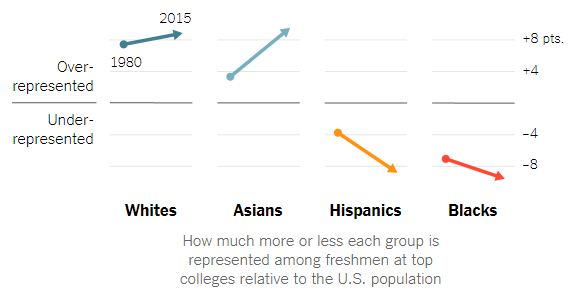Literature Post #4, Black and Hispanic Representation at Top Colleges
Key Terms:
Affirmative Action: the policy or practice of allocating available resources in favor of groups who have previously or presently face discrimination.
Racial Gap: a disparity of success and well being between two or more races, usually concerning wealth, education, and employment.
Enrollment Representation: the balance demographics of a state or nation's college enrollment versus the total population of college age people from these same demographics.
Quotes:
"Black students make up 9 percent of the freshmen at Ivy League schools but 15 percent of college-age Americans, roughly the same gap as in 1980. (A category for multiracial students, introduced in 2008, has slightly reduced the share of black students.)"
"The number of Hispanic and black freshmen on the University of California campuses declined immediately after California’s affirmative action ban took effect, especially at the most sought-after campuses, said Stephen Handel, associate vice president for undergraduate admissions. The system put the ban in place in 1998."
"Affirmative action increases the numbers of black and Hispanic students at many colleges and universities, but experts say that persistent underrepresentation often stems from equity issues that begin earlier."
Authors:
Jeremy Ashkenas, Haeyun Park, and Adam Perce are all journalists with several years of experience both reporting and working with The New York Times, with Ashkenas joining as early as 2011. They all hold different positions, working in multiple fields of study with a heavy portfolio into politics, sociology, and social issues.
Citation:
Ashkenas, Jeremy, et al.
“Even With Affirmative Action, Blacks and Hispanics Are More Underrepresented
at Top Colleges Than 35 Years Ago.” The New York Times, The New York
Times, 24 Aug. 2017,
www.nytimes.com/interactive/2017/08/24/us/affirmative-action.html.

Comments
Post a Comment